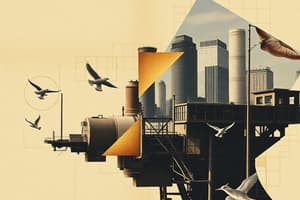Podcast
Questions and Answers
What is the central feature of a command economy?
What is the central feature of a command economy?
- Centralized decision-making and planning by authorities (correct)
- Decentralized decision-making by individuals
- Free-market dynamics driven by consumer preferences
- Integration of customs and community cooperation
Which of the following best describes the major characteristic of the U.S. economic system?
Which of the following best describes the major characteristic of the U.S. economic system?
- Relying solely on trade with other countries
- Predominantly a market economy with strong principles of capitalism (correct)
- Equal distribution of resources managed by the community
- Complete government control over production
How do prices function in the U.S. economy?
How do prices function in the U.S. economy?
- Prices are fixed by government regulations
- Prices serve as signals indicating demand and supply (correct)
- Prices are determined solely by historical data
- Prices function independently of market trends
What does GDP growth rate indicate?
What does GDP growth rate indicate?
Which factor is NOT typically associated with economic health?
Which factor is NOT typically associated with economic health?
What does supply refer to in an economic context?
What does supply refer to in an economic context?
Which of the following best describes a command economy?
Which of the following best describes a command economy?
What is an example of opportunity cost?
What is an example of opportunity cost?
What role does globalization play in the economy?
What role does globalization play in the economy?
Which factor of production involves human effort?
Which factor of production involves human effort?
Why do businesses exist in an economy?
Why do businesses exist in an economy?
What is the fundamental economic problem that arises from limited resources and unlimited wants?
What is the fundamental economic problem that arises from limited resources and unlimited wants?
Flashcards are hidden until you start studying
Study Notes
Supply and Demand
- The quantity of a product producers are willing to sell at various prices is known as supply.
- Demand refers to the quantity of a product consumers are willing to buy at different price levels.
- The interplay of supply and demand determines market prices and economic equilibrium.
Factors of Production
- Land encompasses natural resources used in production, such as minerals and water.
- Labor represents human effort, both physical and mental, employed in creating goods and services.
- Capital comprises man-made resources, including machinery and factories, used for production.
- Entrepreneurship embodies the drive to innovate and take risks in establishing new businesses or products.
Four Economic Systems
- A traditional economy relies on customs, history, and time-honored beliefs; often found in rural, agricultural societies.
- In a command economy, the government controls production, distribution, and prices; usually associated with socialist or communist systems.
- Market economies base decisions on interactions between citizens and businesses, driven by consumer choice and competition.
- A mixed economy blends elements of market and command economies, with both the government and private sector playing significant roles.
Globalization
- Globalization refers to the increasing interdependence of economies worldwide, propelled by trade, investment, and technology.
- It facilitates the flow of goods, services, capital, and labor across borders.
- While it leads to cultural exchange, globalization can create economic disparities and challenges for local industries.
Scarcity
- A fundamental economic problem arising from limited resources and unlimited wants.
- This forces individuals and societies to make choices about resource allocation.
- It highlights the necessity of prioritizing and managing resources effectively.
Opportunity Cost
- The value of the next best alternative forgone when making a choice.
- It is important for individuals and businesses to consider trade-offs in decision-making.
- Opportunity cost helps evaluate the benefits of different options and their potential outcomes.
Why Businesses Exist
- To meet consumer needs and desires by providing goods and services.
- Driven by the profit motive, where businesses aim to maximize revenues while minimizing costs.
- Businesses create jobs, stimulate economic growth, and drive innovation within the economy.
Why Societies Develop Economic Systems
- To address the problem of scarcity by organizing production, distribution, and consumption of goods.
- Economic systems provide a framework for deciding how resources are allocated.
- They help define the roles of individuals and institutions in an economy.
Basic Features of Different Economic Systems
- Traditional: Emphasis on customs and community cooperation with little innovation.
- Command: Centralized decision-making and planning by authorities.
- Market: Consumer sovereignty where supply and demand dictate production.
- Mixed: Balance between government regulation and market freedom for equitable distribution.
Major Features of the U.S. Economic System
- Predominantly a market economy with strong principles of capitalism.
- Emphasis on private property rights and minimal government intervention.
- Competition fosters efficiency and innovation among businesses.
Role of Markets and Prices in the U.S. Economy
- Markets facilitate transactions between buyers and sellers, influencing the allocation of resources.
- Prices serve as signals that communicate information about demand and supply.
- Fluctuations in price help balance excess supply or demand, maintaining market equilibrium.
Factors that affect economic health of a country
- GDP Growth Rate: Represents the percentage change in a country's total economic output over a specific period, signifying whether the economy is expanding or contracting.
- Unemployment Rate: Shows the percentage of the labor force that is actively seeking work but unable to find it, indicating the level of job availability in the economy.
- Inflation Rate: Measures the rate at which prices for goods and services rise over time, signifying potential economic instability if excessively high.
- **Education level:**The quality and accessibility of education in a country, which impacts the overall skill level of the workforce and economic potential.
Studying That Suits You
Use AI to generate personalized quizzes and flashcards to suit your learning preferences.




